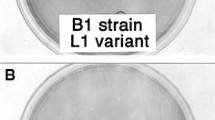Summary
The intracellular synthesis of virus-specific polypeptides in cells infected with the wild-type virus of HVJ (HVJ-W) (haemagglutinating virus of Japan—the Sendai strain of parainfluenza 1 virus) and with a temperature-sensitive(ts) mutant (HVJ-pB) derived from an HVJ carrier culture has been analysed by polyacrylamide gel electrophoresis. At the permissive temperature (32° C), all of the known virus structural polypeptides were identified in cells infected with each strain of virus and in addition to the non-structural polypeptides B and C, another polypeptide at the region with a molecular weight of 26,000 to 27,000 (26 to 27K) could be detected in infected cells. At the non-permissive temperature (38° C), the synthesis of the polypeptide M was markedly restrained in cells infected with HVJ-pB, while other major virus polypeptides were present in approximately comparable amounts to cells infected with the wild-type virus. A non-structural polypeptide with a molecular weight of 105K was dominant ints mutant infected cells at higher temperatures and disappeared after temperature-shift from 38° to 32° C. The production of the non-structural polypeptides B and 27K was also temperature-sensitive. The molecular weights of the polypeptides B, M and 27K in HVJ-pB infected cells were larger than those of the corresponding polypeptides in HVJ-W infected cells. The synthesis of the M protein in HVJ-pB infected cells started just after lowering the incubation temperature and the newly made M protein was successfully incorporated into virus particles.
Similar content being viewed by others
References
Anderson, L. E., McClure, W. O.: An improved scintillation cocktail of high-solubilizing power. Anal. Biochem.51, 173–179 (1973).
Bonner, W. M., Laskey, R. A.: A film detection method for tritium-labeled proteins and nucleic acids in polyacrylamide gels. Europ. J. Biochem.46, 83–88 (1974).
Homma, M.: Trypsin action on the growth of Sendai virus in tissue culture cells. 1. Restoration of the infectivity for L cells by direct action of trypsin on L cell-borne Sendai virus. J. Virol.8, 619–629 (1971).
Huang, A. S., Baltimore, D.: Defective viral particles and viral disease processes. Nature (London)226, 325–327 (1970).
Kimura, Y.: Isolation and characterization of temperature-sensitive viruses derived from HVJ (Sendai virus) carrier cell cultures (in Japanese). Virus24, 376–378 (1974).
Kimura, Y., Ito, Y., Shimokata, K., Nishiyama, Y., Nagata, I., Kitoh, J.: Temperature-sensitive virus derived from BHK cells persistently infected with HVJ (Sendai virus). J. Virol.15, 55–63 (1975).
Kimura, Y., Ito, Y., Nagata, I., Yoshii, S., Maeno, K., Matsumoto, T.: Surface antigens on HeLa cells persistently infected with HVJ (Sendai virus). Arch. Virol.51, 275–283 (1976).
Kimura, Y., Norrby, E., Nagata, I., Ito, Y., Shimokata, K., Nishiyama, Y.: Homologous interference induced by a temperature-sensitive mutant derived from an HVJ (Sendai virus) carrier culture. J. gen. Virol.33, 333–343 (1976).
Laemmli, U. L.: Cleavage of structural proteins during the assembly of the head of bacteriophage T4. Nature (London)227, 680–685 (1970).
Lamb, R. A., Mahy, B. W. J., Choppin, P. W.: The synthesis of Sendai virus polypeptides in infected cells. Virology69, 116–131 (1976).
Lamb, R. A., Choppin, P. W.: The synthesis of Sendai virus polypeptides in infected cells. 3. Phosphorylation of polypeptides. Virology81, 382–397 (1977).
Madore, H. P., England, J. M.: Selective suppression of cellular protein synthesis in BHK-21 cells infected with rabies virus. J. Virol.10, 1351–1354 (1975).
Maeno, K., Yoshii, S., Nagata, I., Matsumoto, T.: Growth of Newcastle disease virus in a HVJ carrier culture of HeLa cells. Virology29, 255–263 (1966).
Maizel, J. V., Jr.: Polyacrylamide gel electrophoresis of viral proteins. In:Maramorosch, K., Koprowski, H. (eds.), Methods in Virology5, 179–246. New York-London: Academic Press 1971.
McCrea, J. F., Epstein, R. S., Barry, W. H.: Use of potassium tartrate for equilibrium density-gradient centrifugation of animal viruses. Nature (London)189, 220–221 (1961).
Morita, O.: Studies on the persistent infection with paramyxovirus: HVJ (Sendai virus) in cultured cells. Juzen Igakukaishi84, 397–406 (1975).
Nagata, I., Kimura, Y., Ito, Y., Tanaka, T.: Temperature-sensitive phenomenon of viral maturation observed in BHK cells persistently infected with HVJ. Virology49, 453–461 (1972).
Nuss, D. L., Oppermann, H., Koch, G.: Selective blockage of initiation of host protein synthesis in RNA-virus-infected cells. Proc. nat. Acad. Sci. (Wash.)72, 1258–1262 (1975).
Peluso, R. W., Lamb, R. A., Choppin, P. W.: Polypeptide synthesis in SV 5-infected cells. J. Virol.23, 177–187 (1977).
Portner, A., Scroggs, R. A., Marx, P. A., Kingsbury, D. W.: A temperature-sensitive mutant of Sendai virus with an altered hemagglutinin-neuraminidase polypeptide: Consequence for virus assembly and cytopathology. Virology67, 179–187 (1975).
Preble, O. T., Youngner, J. S.: Temperature-sensitive mutant viruses and the etiology of chronic and inapparent infections. J. inf. Dis.131, 467–473 (1975).
Scholtissek, C., Rott, R., Klenk, H.-D.: Two different mechanisms of the inhibition of the multiplication of enveloped viruses by glucosamine. Virology63, 191–200 (1975).
Sever, J. L.: Application of a microtechnique to viral serological investigations. J. Immunol.88, 320–329 (1962).
Scheid, A., Choppin, P. W.: Identification of biological activities of paramyxovirus glycoproteins. Activation of cell fusion, hemolysis, and infectivity by proteolytic cleavage of an inactive precursor protein of Sendai virus. Virology57, 475–490 (1974).
Sugita, K., Maru, M., Sato, K.: A sensitive plaque assay of Sendai virus in an established line of monkey kidney cells. Japan. J. Microbiol.18, 262–264 (1974).
Weber, K., Lazarides, E., Goldman, R. D., Vogel, A., Pollack, R.: Localization and distribution of actin fibers in normal, transformed and revertant cells. Cold Spring Harbor Symposia on Quantitative Biology39, 363–370 (1974).
Winberg, G., Wadell, G.: Structural polypeptides of adenovirus type 16 incomplete particles. J. Virol.22, 389–401 (1977).
Author information
Authors and Affiliations
Additional information
With 4 Figures
Rights and permissions
About this article
Cite this article
Kimura, Y., Örvell, C. & Norrby, E. Characterization of the polypeptides synthesized in cells infected with a temperature-sensitive mutant derived from an HVJ (Sendai virus) carrier culture. Archives of Virology 61, 23–33 (1979). https://doi.org/10.1007/BF01320588
Received:
Accepted:
Issue Date:
DOI: https://doi.org/10.1007/BF01320588



